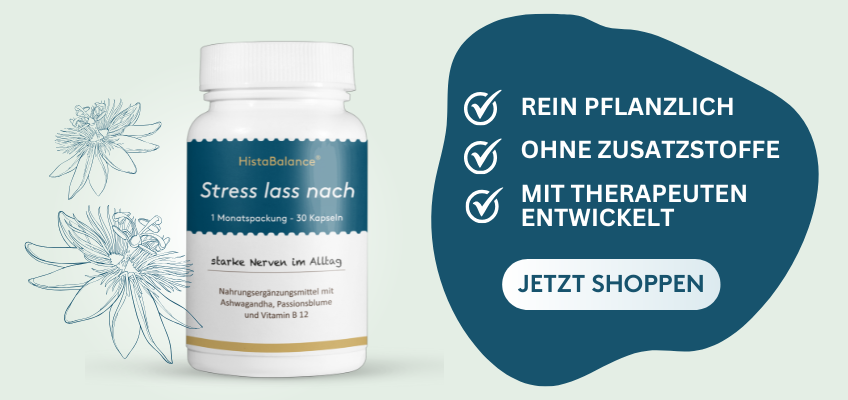
Which drugs are compatible with histamine intolerance?
In people with histamine intolerance, the body has difficulty reducing excess histamine. This can lead to a variety of symptoms if affected foods or substances consume that contain histamine or promote its release. For this reason, it is important for those affected not only to pay attention to the corresponding foods, but also to manage their own medication cabinet.
4 reasons why medication can be incompatible
- Histamin liberators: Some medications can promote the release of histamine from the mast cells in the body. This can lead to an overload of histamine removal in people with histamine intolerance and cause symptoms.
- Histamine -like structures: Some drugs have chemical structures that resemble histamine or can act on similar receptors. This can also lead to an increased histamine -mediated reaction.
- Enzyme inhibition/DAO blocker: The enzymes that break down histamine, especially diaminoxidase (DAO) and histamine N-methyltransferase (HNMT), can be inhibited by certain medications. If these enzymes do not work effectively, histamine can accumulate in the body and cause symptoms.
- Conservatives and additives: Some drugs contain preservatives or other additives that can promote the release of histamine in sensitive people or trigger an intolerance reaction.
Share information about your brand with your Customers. Describe A Product, Make Announcements, Or Welcome Customers to your Store.
Which medication were classified as intolerable?
Antibiotics:
Most antibiotics are rather bad than quite tolerated. Nevertheless, it should not be dispensed with if there is a bacterial infection. It is best to have an antibiogram carried out at the doctor to test the effectiveness of an antibiotic on the pathogen. So you do not unnecessarily occupy an antibiotic that may not work. Antibiotics should always be taken according to the doctor's dosage instructions and should not be canceled beforehand, because a bacterial infection cannot be trifled with. During and after an antibiotic intake, the intake of intestinal bacteria should begin to rebuild the intestinal milieu.
🟠 Histamin liberator:
- Cefuroxim
- Chlortetra cycline
- Ciprofloxacin
- Amphotericin B
- Levofloxacin
- Polymyxin B
- Rifampicin
- Rifaximin
- Teicoplanin
- Vancomycin
🟡 enzyme blocker:
- Cefotiam
- Clavulanic acid
- D-cycloser
- Framycetine
- Neomycin
- Pentamidine
NSAID (anti -inflammatory painkillers):
NSAID stands for non -steroidal anti -rheumatics. This group of medication is often used to treat pain, inflammation and fever. They are non-steroidal, which means that they do not contain steroids. They work by inhibiting the production of prostaglandins that cause inflammation, pain and fever. The tolerance of NSAID medication is very individual and should be tested. The additives in the medication often also play a major role in compatibility. More compatible variants are probably: Etoricoxib, Celecoxib, paracetamol (but is not one of the NSAIDs because it has no anti -inflammatory effect).
🟠 Histamin liberator:
- Ibuprofen/dexibuprofen: (Test to the compatibility, as it is well tolerated by many of those affected)
- Ass, acetylsalicylic acid (e.g. aspirin)
- Diclofenac (e.g. voltaren)
- Naproxen
- Indometacin (with gout and rheumatoid arthritis)
Proton pump inhibitor (PPI):
Proton pump inhibitors (PPI) are a class of medication that reduces the production of gastric acid. They are often used to treat diseases associated with excess stomach acid. The symptoms of too much stomach acid and too little stomach acid are often very similar. Therefore, before taking proton pump inhibitors, it should be clarified whether there is really a surplus or a lack of gastric acid. Most PPIs are well tolerated in a histamine intolerance. These include in particular: omeprazole, esomeprazole, lansoprazole, pantoprazole, rabeprazole.
Taking proton pump inhibitors should be kept as short as possible and as short as possiblebecause they can have many side effects. In addition, the risk of intestinal infections increases, since the germs are no longer killed by sufficient stomach acid. The risk of a lack of nutrients and a dependency also increases.
Antidepressants/psychotropic drugs:
Since histamine is a neurotransmitter in the brain, psychological problems are often the result of histamine intolerance. Antidepressants or psychotropic drugs are often prescribed. The tolerance of these medication is very individual and should therefore be tested. The non-compatible antidepressants include the tricyclic antidepressants and the selective serotonin reuptake inhibitors. In any case, therapeutic accompaniment is advisable to get to the bottom of fears and emotional disorders. In addition, there are already many natural nutritional supplements that have a positive effect on the psyche. Before the psychotropic drug is used, the natural alternatives should definitely be tested, since there is also a high risk of dependency and unwanted side effects.
🟡 enzyme blocker:
- Diazepam
- Diphenhydramine (sedative)
- Promethazine
- Thiopental
Sleep and anesthetic:
Sleep disorders are also symptoms of histamine intolerance, since histamine is involved in the sleep-wake rhythm. Sleep is also a strong antihistamine because histamine is broken down during sleep. Good sleep hygiene and a regular sleep rhythm are therefore very important. Before you use a sleeping pills, you should always test natural methods in the form of Teas or Dietary supplements For stress relief. Fixed sleep rituals and meditation exercises before going to bed can also be helpful.
🟠 Histamin liberator:
- Barbiturate
X -ray contrast medium:
An X -ray contrast medium is a substance that is used during an X -ray examination or another imaging examination to make certain structures more clearly visible in the body. These agents improve the contrast of the images so that doctors can better assess tissue, organs and blood vessels. In the case of X-ray contrast agents, a distinction is made between iodine-containing contrast agents (for CTS and angiographies), barium saclat (gastrointestinal investigations) and gadolinium-containing contrast medium (with MRI).
X -ray contrast agents are generally not well tolerated, so that the examination should always be tried without the contrast medium. The iodine -containing contrast medium in particular can cause strong symptoms. Before the examination, it should therefore urgently be pointed out to histamine intolerance. All X -ray contrast agents are to be classified as histamine liberators.
Local anesthetic/narcotic:
In the case of a narcotic or local anesthesia, the anesthetist treating should always be spoken to beforehand and referred to histamine intolerance. In the meantime, more and more anesthesia have been aware of this topic. When choosing the anesthetic, it is always important to ensure that it does not require any preservatives and does not contain any incompatible auxiliary substances. Better tolerable active ingredients include diazepam, fentanyl, sufenanil, piritramide, propofol, ketamine, mepicacain, isofluran, or Sevofluran. If you have reacted strongly to a narcotic in the past, the administration of antihistamines makes sense. However, this should definitely be discussed with the anesthetist.
🔴 Not tolerated:
- Curare
- Methexital
- Procain
- Propanide
- Morphine
- Codeine
- Tramadol
- opiate
- Thiopental
- phenobarbital
- Lidocaine
Antihistamines:
Antihistamines block certain histamine receptors and thus act against histamine -related symptoms. So they ensure that the effect of histamine is temporarily suppressed, i.e. not that the histamine level is reduced. There is only no information transfer that should be distributed. So far there are four different histamine recipe types: H1 to H4. Antihistamines often only appear receptor -specific and bind one of the 4 receptors. With the H1 receptor, most of the histamine -related symptoms can be suppressed. The H2 receptor makes sense for complaints from the digestive tract. H3 and H4 receptors have so far hardly have a therapeutic meaning. Well -known and tolerable antihistamines are, for example, Cetirizin (can make slightly sleepy), desloratadine, fexofenadin, fenistil and loratadine.
Enzyme blocker:
- Cimetidin (H2 antihistamine)
- Diphenhydramine
- Promethazine
Coughing medium:
In the case of colds, coughing with the active ingredient thyme should be used to solve the mucus. It should be noted that the means of choice contains as few additives as possible. However, it is best to brew a tea of thyme and sage and to drink it throughout the day.
🟠 enzyme blocker
- Ambroxol
🟡 Histamine liberator
- Codeine
Share information about your brand with your Customers. Describe A Product, Make Announcements, Or Welcome Customers to your Store.
Advertising
Stress let go
The stress let for Formula Extracts from Ashwagandha, passion flower and Vitamin B12 Help you find the inner balance.
Collapsible content

From those affected for those affected
We are Thomas and Michaela Zinser, founder of Histaminikus.
Because of the own histamine intolerance of Michaela and our son, we founded Histaminikus. The frustration does not find any suitable histamine food has spurred us to develop low -histamine food.
We would like to give you back a piece of quality of life. Feel free to look around with us.
Kind regards
Thomas and Michaela







